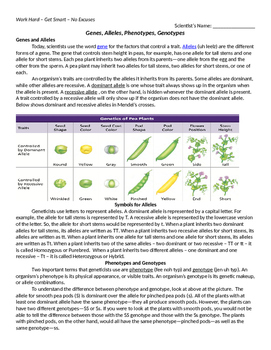Genes, Alleles, Phenotypes, Genotypes Reading Comprehension
- Word Document File
What educators are saying
Description
**Distance Learning and Remote Learning Appropriate
This reading comprehension explores genetic This article explores genetic disorders. It provides a great real-world application to a genetic unit, which gives students meaning and purpose to their classroom learning. It is exciting and applicable to modern-day science progressions. The article is written in friendly and engaging language. The article is a little more than a page long and includes standards-aligned comprehension and analyses questions. The article can be used for literacy groups, individual DEAR or homework reinforcement.. It provides a great real-world application to a genetic unit, which gives students meaning and purpose to their classroom learning. It is exciting and applicable to modern-day science progressions. The article is written in friendly and engaging language. The article is a little more than a page long and includes standards-aligned comprehension and analyses questions. The article can be used for literacy groups, individual DEAR or homework reinforcement.



